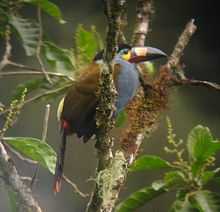Plate-billed mountain toucan
| Plate-billed mountain toucan | |
|---|---|
 | |
| In northwestern Ecuador | |
| Conservation status | |
| Scientific classification | |
| Kingdom: | Animalia |
| Phylum: | Chordata |
| Class: | Aves |
| Order: | Piciformes |
| Family: | Ramphastidae |
| Genus: | Andigena |
| Species: | A. laminirostris |
| Binomial name | |
| Andigena laminirostris Gould, 1851 | |
The plate-billed mountain toucan (Andigena laminirostris) is a species of bird in the family Ramphastidae. It is native to Colombia and Ecuador, where it occurs in the high-altitude humid montane forests of the Andes. It is one of five species in genus Andigena, the mountain toucans.[2]
Other common names include plain-billed mountain-toucan, laminated mountain-toucan, and hill-toucan in English, toucan montagnard in French, Leistenschnabeltukan in German, and tucán piquiplano in Spanish.[3]
Description
The plate-billed mountain toucan is about 42 to 53 centimeters (16.5 to 21 inches) in length, with a relatively lightweight bill up to 10 centimeters long. The average male weighs about 314 grams (11.1 ounces) and the female about 303 grams (10.7 ounces). It is zygodactylous, with two toes forward and two pointing back.
The upper parts and wings are golden olive in color and the underparts are bright blue with yellow lateral patches. The crown and nape are black, the rump is bright yellow, and the thighs are reddish brown. The tail feathers are gray with dark green and red coverts. The face has patches of yellow and yellow-green and the iris is red. The bill is black with areas of red and ivory.
Vocalizations
This is the most vocal of the mountain toucans, and the sexes often duet. The male makes a loud, repeating tryyyyyyyk sound and the female makes a drier t't't't't't't't noise. The bird utters rattles and clicks so loud they can be heard over a kilometer away.
Habitat
The bird occupies humid Andean forest and shrubland among bromeliads and mosses. It occurs between 300 and 3200 meters in elevation, mostly remaining between 1200 and 2500 meters. Its home forests receive some 14 feet of rainfall per year.[4]
Behavior
Diet
This bird feeds mainly on fruit, occasionally eating insects and eggs, as well.[4] It disperses the seeds of plants such as the mountain understory shrub Faramea affinis[5] and the palm Prestoea acuminata.[6] There has been a report of the bird eating a caecilian (Caecilia sp.)[7]
Breeding
The breeding season extends from March to October, peaking in May through August. The bird nests in tree cavities up to 30 meters above the ground. The clutch contains 2 or 3 white eggs. The eggs are incubated for about 16 days and the young fledge at 46 to 60 days. Once the young depart, the pair may rear a second brood.[4]
Conservation
The species is in decline because its habitat is being lost to deforestation. It is also poached for the trade in exotic birds. It is still a "fairly common" species.[1]
This is the flagship bird of the La Planada Nature Reserve in Colombia.[8]
References
- ↑ 1.0 1.1 BirdLife International (2012). "Andigena laminirostris". IUCN Red List of Threatened Species. Version 2013.2. International Union for Conservation of Nature. Retrieved 26 November 2013.
- ↑ Lutz, H. L., et al. (2013). Biogeography and spatio-temporal diversification of Selenidera and Andigena toucans (Aves: Ramphastidae). Molecular Phylogenetics and Evolution, in press.
- ↑ Plate-billed Mountain-toucan (Andigena laminirostris). The Internet Bird Collection.
- ↑ 4.0 4.1 4.2 Ramphastidae. Nashville Zoo.
- ↑ Restrepo, C. and A. Vargas. (1999). Seeds and seedlings of two neotropical montane understory shrubs respond differently to anthropogenic edges and treefall gaps. Oecologia 119(3) 419-26.
- ↑ Gamba-Trimiño, C., et al. (2011). Demography of the clonal palm Prestoea acuminata in the Colombian Andes: sustainable household extraction of palm hearts. Tropical Conservation Science 4(4) 386-404.
- ↑ Solano-Ugalde, A. (2011). The Plate-billed Mountain Toucan (Andigena laminirostris) feeding on a Caecilia spp (Gymnophiona: Amphibia). Boletín SAO 20(2) 43-5.
- ↑ Vallejo, M. I., et al. (2004). La Planada forest dynamics plot, Colombia. Tropical Forest Diversity and Dynamism: Findings from a large scale plot network.
External links
| Wikimedia Commons has media related to Andigena laminirostris. |
- Andigena. ITIS
- Plate-billed Mountain-toucan, Andigena laminirostris. BirdLife International.
| ||||||||||||||||||||||||||||||
